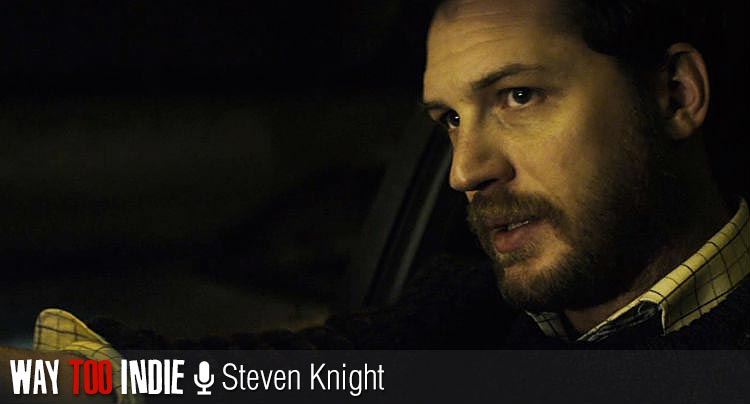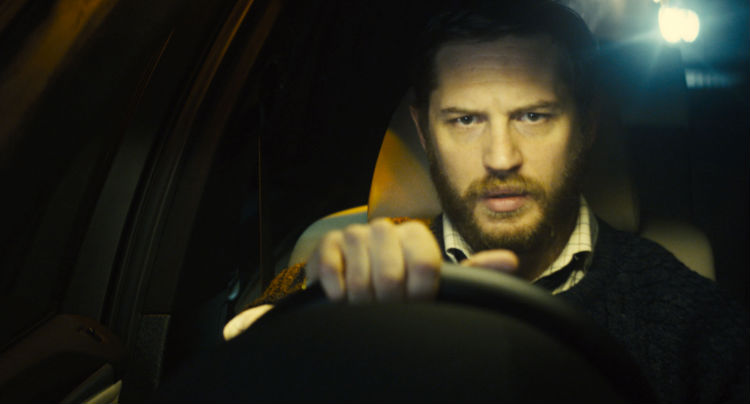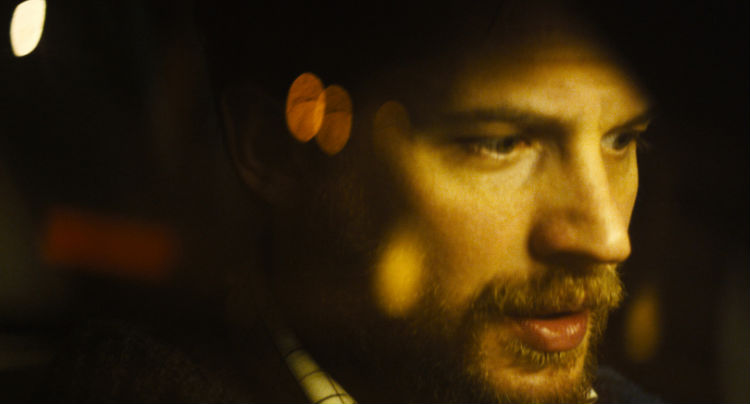Steven Knight Talks ‘Locke’, the Theater of the Automobile

In Steven Knight’s experimental chamber piece Locke, we follow construction manager Ivan Locke (Tom Hardy) who, while driving on a highway late at night, has his whole world crumble around him as he desperately tries to keep his calm, cool exterior. Locke’s composure is tested as he juggles ongoing phone conversations with his wife (Ruth Wilson), his co-worker (Andrew Scott), and a woman with whom he’s been inextricably, unwillingly, linked. The entirety of the film takes place in Locke’s car on his night drive from Birmingham to London, with Hardy occupying the screen at virtually all times.
In our sit-down interview, Knight spoke with us about his fascination with cars driving on highways at night, keeping the one-location film visually interesting, Tom Hardy’s accent, why the movie isn’t quite in real time, and more.
Locke opens this Friday, 5/2 in San Francisco. Check back then for our full-length review.
What is it about a car moving through an urban environment at night that you love?
Steven: I’d just finished directing a conventional film. We tested the ALEXA cameras before we started shooting to see how sensitive they were to light at night when filming in London. We drove around with a camera and shot roads and buildings at night. When we sat in the cinema to watch that footage, I found it absolutely fascinating. I thought it was beautiful. One of the first thoughts was that it could be an art installation where you just leave the camera and just see stuff. The lights go by, the cars become spots of light as they go out of focus…Maybe it’s just me.
I thought, maybe you could make that car a theater. The screen then becomes a theater with those images on it. That’s your theater. You then put an actor into that theater and shoot a play as he drives. I write a lot of conventional film scripts in all kinds of different genres. This is a deconstruction of the journey, the character arc, the three acts…all of those things. The car journey is a real journey. The character arc doesn’t change much, but we’re completely looking at his character. I sincerely believe that, no matter what the budget and no matter what special effects, when people look at the screen, they look at the eyes of the actor. That’s where they’re looking. That’s where the answers are; they want to know what’s going on inside that person’s head, no matter what the film is.
I just thought, is it enough if you concentrate it down to that? Everything’s simplified: The journey is a journey. The eyes of the actor are all you’ve got. The future is through the windscreen and the GPS. The past is the rearview mirror. Everything’s simple in the car, and the world around it is chaos: lights and movement. You have a concrete man in the middle trying to bring order to it. Of course, it’s not possible, but he tries.
“It’ll be okay.”
Steven: “Let’s move on to the practical next step.”

The obvious challenge for films shot in a single, enclosed space like Locke is that there are only so many spots you can place your camera, and yet you have to keep the film visually interesting throughout. There’s a great shot where the camera is planted on the side of the car, you can see Tom in the side mirror, and he looks a million miles away.
Steven: It was fun. For everybody concerned, it was sort of a holiday from what they do, including myself. People dread doing car stuff. It’s so difficult and painful, and continuity is so difficult, normally. With this film, the initial thought was that all of the phone conversations have to take place on the same part of the same motorway, for continuity. That’s nonsense. Who cares what the lamp posts look like? You can get rid of continuity and do anything you want. We had three cameras rolling at all times: one that was conventional, one that was a bit less conventional, and one that was having fun. You set up these cameras while it’s still daytime, you get it all ready, and off you go.
The Red camera has a memory card of 30 minutes, so every 27 minutes we’d pull over like a Formula 1 pitstop. Everyone knew what they were going to do: change the memory card, change the lens, change the angle. Everybody leaves Tom alone because he’s in character. Then, you set off.
We got all of the other actors into a conference room in a hotel, opened up a phone line from that conference room. I was on the back of the truck with Tom, and I would cue the actors in sequence to make their calls. We shot the whole film, beginning to end, twice a night. We didn’t always manage to get twice a night–some were lighter–but we ended up with 16 movies.
And you’ve seen them all!
Steven: Yeah. The one we chose has all the best bits. We found that we kept returning to the same nights, the same sequences. It was usually around 2, 3 in the morning when everyone was a bit down. Suddenly, everything worked perfectly. Then, we just cut between the three cameras that were rolling.
Tom has a fascination with accents.
Steven: Yes!
He loves trying them on. Is it a Welsh accent in the film?
Steven: The point was that I wanted him to be from a poor background, a difficult upbringing. Most British working-class accents come with a lot of baggage. They’re quite harsh. With the Welsh accent, it’s very plausible that he’d be from a poor background, but it’s quite lyrical. He listened a lot to Richard Burton reading “Under Milk Wood”, the Dylan Thomas thing, before we’d start shooting. Rather than do accents, he’ll do someone with that accent. He knows someone with a Welsh accent, so he just becomes him for a bit, in terms of the voice. There’s no voice coach saying, “This is what a Welsh accent sounds like.” I think that’s death for any actor. Welsh was perfect.
Some of the best moments in the film are when you feel, “Any second now, he’s going to burst. I can see it in his eyes. Any second now.” But then…he doesn’t. The few times he does erupt are great, but the times when he doesn’t are so much fun.
Steven: If you’re going to have someone on screen the whole time, they’d better be good, and I think Tom’s the best we’ve got. Before writing the script I was meeting him for something else, and I said, “I’ve got this idea for the theater of this moving image. A man’s life unravels, and he’s the most ordinary man in the world.” He was really engaged. You need someone who people want to look at for that long. You also need him to keep the emotion down…keep everything under control. Everybody else can go mad and break down, but he can’t. “You’re the driver. You can’t.”
My favorite scene is when Locke is so frustrated with Donal, and they’re both absolutely furious, screaming at each other. Then, they begin laughing, because it’s the only place for them to go from there!
Steven: They’re good friends Andrew and Tom. We did it various ways, and one night, Andrew just started going, “FUCKIN’ HELL YOU FUCK!” Tom just started laughing and we went with it. It’s brilliant. It’s the only time you see him laugh, in that moment. The world is falling apart, but we’re human, and when something funny happens, you just laugh. Andrew is so good.
The supporting actors in the film deserve a lot of credit. They’re great.
Steven: In the UK, they’re the best character actors we’ve got. Our first choices all said yes, which is amazing. All we were offering them was 9pm to 4am in a conference room with some red wine and some biscuits. That was it, and they all said yes. Olivia Colman, Ruth Wilson and Andrew Scott are the best.
What’s great about those conversations–especially in a movie like this–is that, as a storytelling tool, you can transport us from the theater of the car to the theater of the mind, where we’re visualizing what these other characters are doing even though we can’t see them.
Steven: Absolutely. Absolutely. One of the best comments that I get from people who have seen the film is that they forget they haven’t seen the other characters. They’ve made them up themselves. The way films are made with budgets and special effects is, you sit in a room, they turn the lights off, and there onscreen is someone else’s imagination. It’s complete. You don’t have to do or add anything. It’s all there. With this film, it’s more like you’re telling a kid a story, and they’re staring off into space because they’re seeing it in their mind. People see the house where Locke’s wife is and the kids are watching football on the TV. They see it all themselves. I think it’s really good to have to use your imagination like that.

The movie’s not quite in real time.
Steven: The reality is that the journey he makes from Birmingham to London is about 2 hours. As a personal policy, I don’t want to make people sit in the cinema for 2 hours. I think it’s too long. In other words, I suggest that there are gaps between calls that we edited. We believed we’d need to pull the camera out and see the car objectively, often, to give people relief. When we showed that to people, they really rejected that. They wanted to stay in the car. It was the reverse of what we thought people wanted.
If I understand correctly, Tom didn’t have enough time with the script, so he didn’t memorize all of his lines.
Steven: We met in November and were shooting by February. I wrote it in between. It’s a 90-page script, which would have been impossible to learn. We put teleprompters in the car. I thought that he’d want to go off script and ad lib. I said that that was perfectly fine, but he said that he prefers to go off the page, which is great for me as the writer. The end product is word-for-word the script, with a couple of small exceptions. The great thing for him was, once he had the teleprompter in front of him, he didn’t have to remember the lines, which causes such anxiety in actors. He’s reading from the page, and it also means that he’s liberated to improvise the performance of everything. I think it works really well.
The production sounds like it was a lot of fun.
Steven: It was cold and wet, but because it was short, everybody gave me a burst of enthusiasm and excitement. It didn’t grow stale. It didn’t matter if they got no sleep, because they knew it was going to be over soon, so they gave it everything they had.
This film ostensibly seems like it would be a compact, restricted production, but in reality, it was quite the opposite. It seems it was freeing for you, creatively.
Steven: It was great. We were left alone completely by IM Global, who financed it. They were brilliant. On the back of two paragraphs, they financed it fully. None of us knew if it was going to work or not, and we didn’t know until Venice, the first screening to the public. The lights went up and it was overwhelming. There was no negativity. There was emotion and tears, a standing ovation. We were completely astonished.
You were surprised?
Steven: Sort of. I thought it was good. Then we showed it to people we liked. Middle aged men who were dragged to the screening were like, “Oh god, this is me. This is my life. I’ve done this. This is my dad’s life.” Really personal stuff. But, maybe it was just because they were people we knew. Then, in Venice, it was again a lot of people I suspected didn’t want to come, but saw something of themselves or their life in the film. Sundance was fantastic. Then, we went to Salt Lake City. Middle America. I thought, this is quite a religious place. It’s not going to go well. But it was the best reaction. You know, long handshakes after the screening. It was always some personal thing.
You weren’t expecting personal reactions to the film?
Steven: Not at all. I was really pleased. It’s certainly not an arthouse response we get. It’s not, “The film was experimental and it’s made me wonder about how we make films.” That’s fine, but it was much more, “That’s made me think about my dad a lot,” do you know what I mean? Really personal comments like that. “This is really close to home.” It’s great. It’s exactly what you want.
